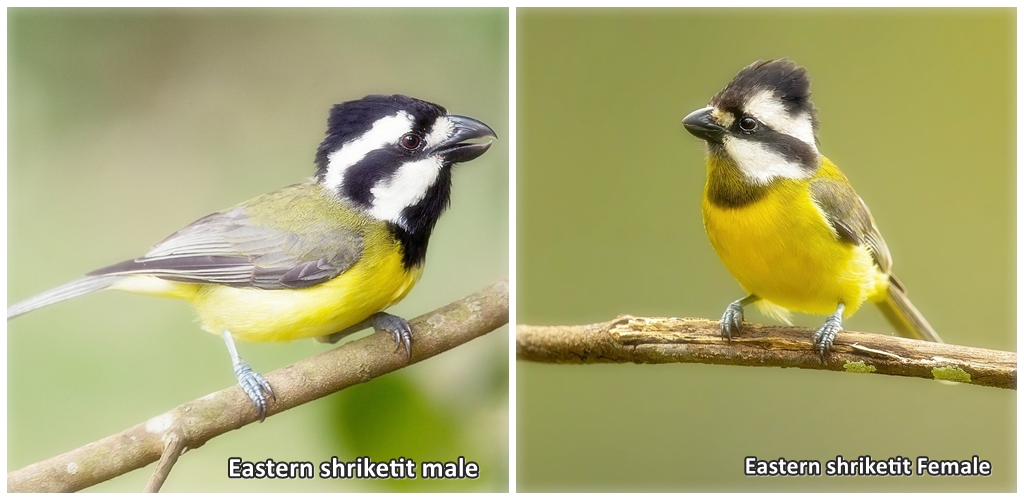Behavior & Habitats: During foraging for spiders, larvae, beetles, and other insects, the Crested Shrike-tit uses its powerful bill in a variety of ways. Peeling bark and decaying wood from tree trunks and branches can be removed, galls can be cut into live twigs, and leaf-tying caterpillar nests can be ripped apart. However, these birds also glean insects from the leaves by hanging upside-down.
Large prey is carried to a suitable perch, pinned down with one foot, and dismembered with the bill. These birds forage in eucalyptus branches of tall forests unobtrusively in pairs, families, or large groups. By flying 50 or more meters through and over the canopy, they work methodically through one tree. Sedentary birds have large foraging territories that can cover more than 50 hectares.
Diet: During the breeding season, they feed mainly on insects, spiders, and young birds. Seeds from thistles are also taken. Their parrot-like bill allows them to access invertebrates via bark-stripping behavior
Other Names: It is also known as Crested Tit, Bark Tit, Eastern Shriketit, Western Shrike-tit, and Northern Shrike-tit.
Size: The size of Crested Shrike-tit is about 160-190 mm in length.

Identification: Male: In an eastern race, the head, chin, and throat are black, with a broad white band across the cheek and another from the eye to the nape; the crown feathers in the crest are erectile. On dusky wing covers, wings, and tail, there is a mid-grey edging on the back and rump that contrasts with the green-olive back and rump.
White edge-tipped outer tail feathers. There is a plain lemon-yellow color from the breast to the undertail. The eyes are red-brown in color. The bill is massive, hooked, and black. The feet are leaden-grey in color. There is a broad white belly in the western race, with a bright citrine back and rump, which washes over the edges of the dusky wing covers, wings, and tails.
Compared to eastern races, northern races combine the upper parts of western races with ventral patterns. Female: Despite being a male of the respective race, the throat is olive-grey; the chin is grey. Immature: As adults, juveniles are pale russet-brown over the back. As juveniles, they have a cream-white throat and pale yellow below; their bills are dusky with pale cutting edges.
Call: During contact, both sexes of Crested Shrike-tits make a drawn-out, high-pitched, slurred whistle. Additionally, two to five syllables can be chuckled or stuttered. There is no noticeable presence of the bird, but it can be heard torning bark strips from trees, which indicates its presence.
Song: In Crested Shrike-tit’s song, contact whistles are closely repeated, finishing in a louder, lower-pitched upslur.
Nesting and Breeding: Females are primarily responsible for building nests. Both sexes may take five months or more to incubate and feed the young. A third bird, probably one of the parents’ offspring, helps parents to feed young in cooperative breeding. Breeding and nesting occur mostly from September to January. This nest is made of fibrous bark strips matted tightly with cobwebs, lined with soft grass and finely shredded bark, and placed in extended vertical branches in the topmost foliage of trees.
Eggs: It is two to three; oval, about 24 x 15 mm, white with freckles of dark brown, slate, and lavender. There is at least a 15-day incubation period, mainly carried out by females. It takes about 15 days for the young to fledge.
Distribution: The Crested Shrike-tit is found in eucalypt woodlands and forest of southwestern Australia, avoiding the Jarrah belt; northern Australia, where it is rare east to McArthur River, NT; eastern Australia, from the Atherton Tablelands to the Mount Lofty Ranges and inland along River Red Gum-lined rivers, avoiding box.
Races: In the southwest, northwest, and east, there are three endemic races.
Northern shriketit (F. whitei), or White’s shrike-tit is found in the Kimberley and Top End of the Northern Territory in north-western Australia.
Western shriketit (F. leucogaster), or white-bellied shrike-tit – is widespread in western Australia’s south-west.
Eastern shriketit (F. frontatus) – occurs in south-eastern Australia from the Lower South East of South Australia to southern Queensland, with some scattered occurrences further north and west. Read More – The Crow like Black Currawong







